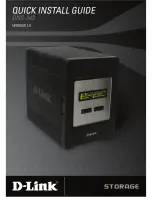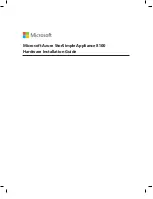
Chapter 21 Classifier
XS1930 Series User’s Guide
183
DSCP
IPv4/IPv6
Select
Any
to classify traffic from any DSCP or select the second option and specify a DSCP (DiffServ
Code Point) number between 0 and 63 in the field provided.
Preceden
ce
Select
Any
to classify traffic from any precedence or select the second option and specify an IP
Precedence (the first 3 bits of the 8-bit ToS field) value between 0 and 7 in the field provided.
ToS
Select
Any
to classify traffic from any ToS or select the second option and specify Type of Service (the
last 5 bits of the 8-bit ToS field) value between 0 and 255 in the field provided.
IP Protocol Select an IPv4 protocol type or select
Other
and enter the protocol number in decimal value. Refer to
for more information.
You may select
Establish Only
for
TCP
protocol type. This means that the Switch will pick out the
packets that are sent to establish TCP connections.
IPv6 Next
Header
Select an IPv6 protocol type or select
Other
and enter an 8-bit next header in the IPv6 packet. The
Next Header field is similar to the IPv4 Protocol field. The IPv6 protocol number ranges from 1 to 255.
You may select
Establish Only
for
TCP
protocol type. This means that the Switch will identify packets
that initiate or acknowledge (establish) TCP connections.
Source
IP
Address/
Address
Prefix
Enter a source IP address in dotted decimal notation.
Specify the address prefix by entering the number of ones in the subnet mask.
A subnet mask can be represented in a 32-bit notation. For example, the subnet mask “255.255.255.0”
can be represented as “11111111.11111111.11111111.00000000”, and counting up the number of
ones in this case results in 24.
Destination
IP
Address/
Address
Prefix
Enter a destination IP address in dotted decimal notation.
Specify the address prefix by entering the number of ones in the subnet mask.
Layer 4
Specify the fields below to configure a layer 4 classifier.
Source
Socket
Number
Note: You must select either
UDP
or
TCP
in the
IP Protocol
field before you configure the
socket numbers.
Select
Any
to apply the rule to all TCP/UDP protocol port numbers or select the second option and
enter a TCP/UDP protocol port number. Refer to
for more information.
Destination
Socket
Number
Note: You must select either
UDP
or
TCP
in the
IP Protocol
field before you configure the
socket numbers.
Select
Any
to apply the rule to all TCP/UDP protocol port numbers or select the second option and
enter a TCP/UDP protocol port number. Refer to
for more information.
Add
Click
Add
to insert the entry in the summary table below and save your changes to the Switch’s run-
time memory. The Switch loses these changes if it is turned off or loses power, so use the
Save
link on
the top navigation panel to save your changes to the non-volatile memory when you are done
configuring.
Cancel
Click
Cancel
to reset the fields back to your previous configuration.
Clear
Click
Clear
to set the above fields back to the factory defaults.
Table 82 Advanced Application > Classifier > Classifier Configuration (continued)
LABEL
DESCRIPTION
















































